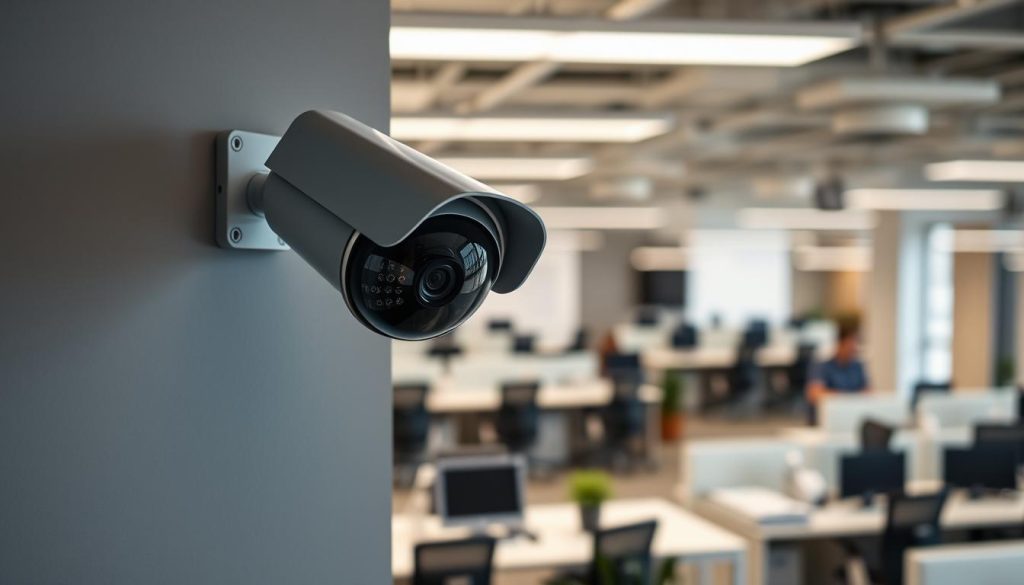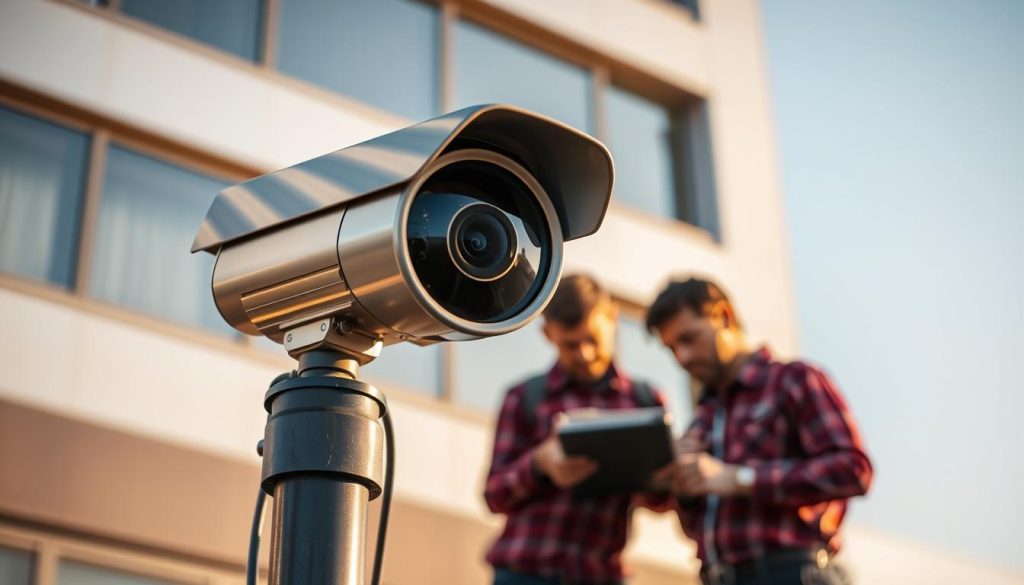Getting security cameras is key for safety and watching over your space. But knowing when to get new ones is just as important. The life of a security camera depends on its type and quality. As tech gets better and the environment changes, it’s important to know when it’s time for new cameras.
This article will help you understand when it’s time for a change. It will guide you in making smart choices.
Key Takeaways
- Knowing how long different cameras last helps plan for replacements.
- Look out for bad image quality as a sign it’s time for new cameras.
- Check for new tech to decide when to upgrade your cameras.
- Things like weather and where you put your cameras affect how long they last.
- Keeping your cameras clean and updating their software can make them last longer.
Understanding the Lifespan of Security Cameras
The lifespan of security cameras changes a lot based on a few key factors. These include the type of camera and where it’s used. Knowing these details helps users pick the right surveillance system.
Average Lifespan by Camera Type
Each security camera type lasts differently. For example, analog cameras can last 5 to 10 years. IP cameras usually last 3 to 5 years. NVR and DVR systems also last as long as analog cameras.
But, high-quality brands like Axis Communications and Uniview can make cameras last over 10 years. On the other hand, cheaper models often break down in 2 to 3 years.
Factors Influencing Lifespan
Things like weather and where the camera is placed affect how long it lasts. Cameras in harsh weather or at risk of damage might not last as long. The quality of the camera’s parts also matters.
Choosing durable parts can make your cameras last longer. For tips on when to replace your CCTV, check out this guide.
Common Signs That Indicate Replacement is Necessary
Knowing when to replace your security cameras is key to good surveillance. There are many signs that show it’s time for a new camera. Spotting these signs helps keep your property safe and well-monitored.
Degradation in Image Quality
Bad image quality is a big warning sign. If your footage looks fuzzy or pixelated, it might be due to worn-out sensors or dirty lenses. Poor images make it hard to spot important details.
Physical Damage or Wear and Tear
Physical damage is another clear sign. Security camera wear and tear can show as cracks or corrosion from being outside too long. Such damage can make the camera stop working right. If you’re having trouble connecting or if the camera isn’t working well, it’s likely time for a new one.
When should I replace my security cameras?
Security technology changes fast. It’s key to know when to update your security cameras. This ensures they keep up with today’s security needs.
Indicators of Technological Obsolescence
Many security cameras get outdated as new models come out. If your system is old and missing important features, it’s time for a new one. Look out for these signs:
- Absence of Modern Features: Cameras without features like motion detection or night vision aren’t good enough.
- Poor Connectivity: If your cameras keep losing connection or don’t work well, it’s a sign they’re too old.
- Difficulty in Integration: Old cameras might not work well with smart home systems, making your security weaker.
- Inadequate Resolution: Cameras with low resolution are not as safe as the high-resolution ones available now.
Checking your security gear regularly helps you see if it’s outdated. If your system is showing signs of being too old, it’s time to look into new cameras. This will help keep your place safe.
Environmental Factors Impacting Camera Longevity
It’s key to know how the environment affects cameras to keep them working well and lasting longer. Outdoor cameras face many weather challenges that can wear them down. Rain, snow, and extreme temperatures are big threats to their durability. Knowing these risks helps in choosing and placing cameras wisely.
Impact of Weather Conditions
Weather can affect cameras in different ways. For instance:
- Rain and moisture: Can cause corrosion if the camera isn’t well-sealed.
- Snow and ice: They can block the camera’s function or even damage it.
- Extreme temperatures: High heat can harm the electronics, while cold can slow them down.
Choosing cameras with the right weatherproof ratings can help them last longer, despite the weather.
Role of Camera Placement
Where you place cameras is very important for their survival. The right spot can make them more durable. Consider these points:
- Location: Cameras in covered spots or under eaves last longer than those out in the open.
- Height and angle: Putting cameras up high can keep them safe from snow and tampering.
- Orientation: Adjusting the camera’s direction can reduce glare from sunrise or sunset, improving its performance and lifespan.
Quality of Components and Its Importance
The materials used in making security cameras are key to their long-term success. Choosing high-quality parts boosts performance and makes cameras last longer. Some brands are known for their strong and durable cameras, even in tough weather.
Key Factors to Consider in Camera Quality
When picking security cameras, focus on a few important things:
- Materials: Choose cameras with top-notch plastics or metals. These materials are tough and can handle harsh weather.
- Environmental Seals: Make sure the camera has weather-resistant seals. This keeps it safe from moisture and dust.
- Lens Quality: Good lenses mean clearer images and a longer camera life.
- Brand Reliability: Go for trusted brands like Axis and Uniview. They offer strong and reliable cameras.
Knowing these factors helps users choose wisely. This leads to a more reliable security system. Quality parts mean your cameras will last and work well in many places.
Regular Maintenance to Extend Camera Lifespan
Regular maintenance is key to keeping security cameras working well for a long time. If you ignore cleaning and inspections, your cameras might not work as well. It’s important to stick to a maintenance plan to keep your system running smoothly.
Importance of Cleaning and Inspections
Cleaning your security cameras is essential for clear images. Dust and dirt can block the lens, making pictures blurry. Regular checks help spot problems early, saving you from expensive fixes and keeping your system strong.
Updating Firmware and Software
Updating your camera’s firmware is also critical. It keeps your system running smoothly and protects it from security threats. A good routine includes cleaning once a month, inspecting every three months, and updating firmware every six months. These steps are vital for your cameras’ performance. For more on when to replace your cameras, see this resource.
Benefits of Upgrading Outdated Cameras
Upgrading your cameras offers many benefits for your security system. You get access to new features that older models didn’t have. These features make monitoring your property easier and more effective.
Access to Advanced Features
New cameras have better resolution, work well in low light, and detect objects more accurately. These improvements give you a clearer view of your surroundings. Plus, they stay up-to-date with the latest software and firmware, keeping your system secure.
Improved Surveillance Efficiency
Upgrading your cameras also means better integration with smart home devices. The new interfaces make it easy to keep an eye on your security system. This leads to a more reliable and responsive monitoring setup.
How to Choose the Right Time for Replacement
Choosing the right time for replacement needs a proactive approach. Regularly checking your security cameras can make them last longer and work better. By doing this, you can spot problems early on.
When you check your cameras, look at a few things:
- Image clarity and resolution.
- Connectivity stability.
- General operational reliability.
Setting up a regular check-up schedule, like twice a year, helps catch issues before they get worse. This way, your security system stays in top shape and meets your needs. Catching problems early can also stop risks from old or broken cameras.

Understanding Camera Types and Their Durability
The life and toughness of security cameras really matter. Knowing the differences between camera types helps pick the right one for your needs.
Analog Cameras vs. IP Cameras
Analog cameras last longer, often 5 to 10 years. This is because they’re simpler and have fewer parts. On the other hand, IP cameras last about 3 to 5 years. They may not last as long but offer better features and functions.
Outdoor vs. Indoor Camera Lifespan
Outdoor cameras face tougher weather and conditions, lasting about 4 to 6 years. Indoor cameras, protected from harsh weather, can last longer. They often serve for years without the damage outdoor cameras face.
Common Issues Leading to Camera Failure
Knowing why cameras fail can help make security systems last longer and work better. Problems with connections and physical damage are big reasons why cameras don’t work right.
Connectivity Problems
Old hardware or a small network range can cause connection issues. When cameras can’t send data, they might miss important things. It’s key to have a strong internet connection for constant monitoring.
Physical Vulnerabilities
Cameras can get damaged by bad weather, vandalism, or accidents. These problems can make security systems weak. To keep cameras working, it’s important to install them right and check them often.
Investment in Quality Cameras for Longevity
Buying quality cameras can save you money in the long run. Choosing durable brands means your system will last longer and work better. Cameras with the latest tech can handle tough weather better than cheaper ones.
Brands Known for Durability
Some companies are known for making tough security cameras. Axis Communications makes cameras that can handle bad weather. Uniview is also popular for its strong and reliable cameras, loved by security experts.
Quality cameras might cost more upfront, but they save you money later. Going for top brands with good warranties shows you value quality. This choice means your investment in safety will last a long time.
Market Trends in Security Camera Technology
The security camera market is changing fast. New trends in security camera technology meet the growing need for better surveillance. Features like AI-driven analytics are key, helping users make smarter choices and monitor in real-time.
These advancements also make it easier to connect security cameras with smart home systems. This allows users to control their security more easily.
Cloud storage solutions are another big change in the surveillance market. They provide more storage and are easy to use. This makes it simpler to get video footage when it’s needed most.
This shift towards cloud storage shows a move towards better, easier-to-use security solutions. In places like Singapore, where keeping property safe is a big deal, this is very important.
To keep up with these changes, it’s important to know about the latest in security camera technology. By understanding what’s new, people and businesses can choose the right technology. This ensures their systems work well and are reliable.
Staying informed about these changes helps make security systems more effective. In today’s fast-changing world, this is key.

